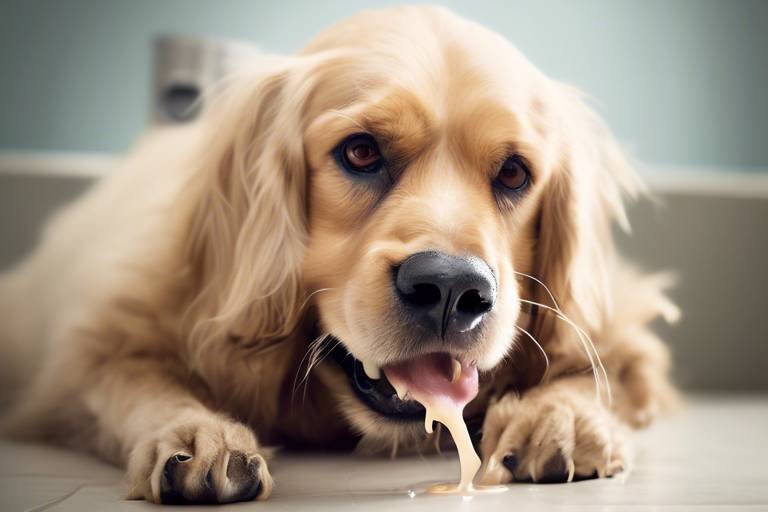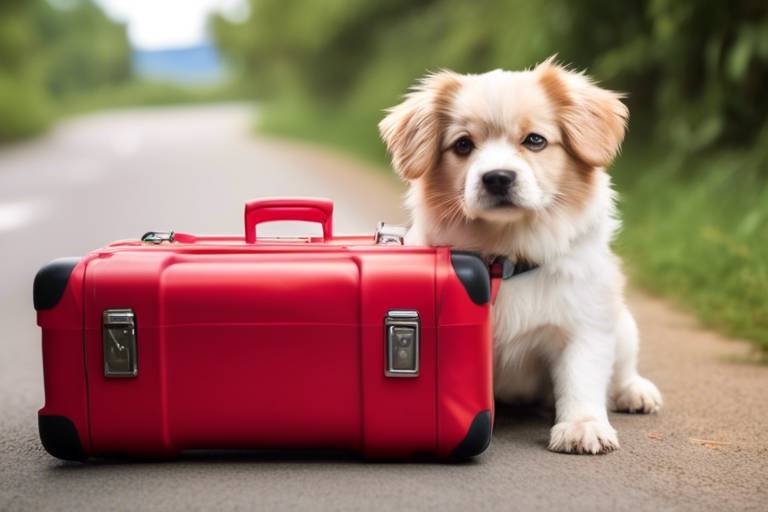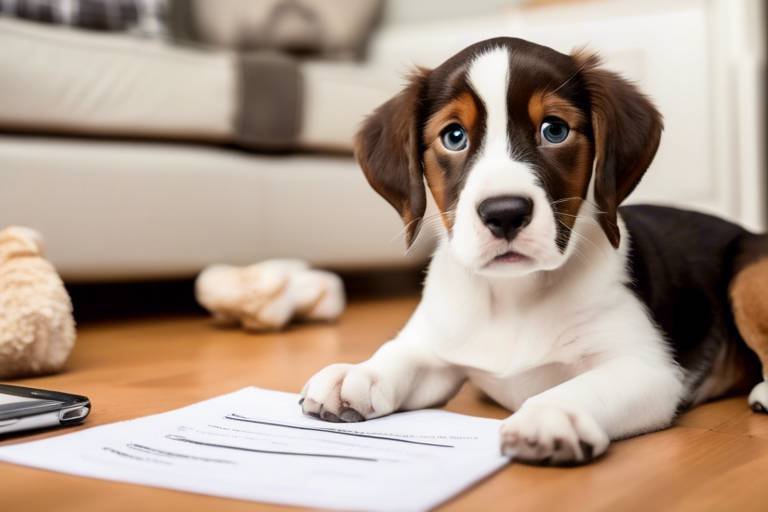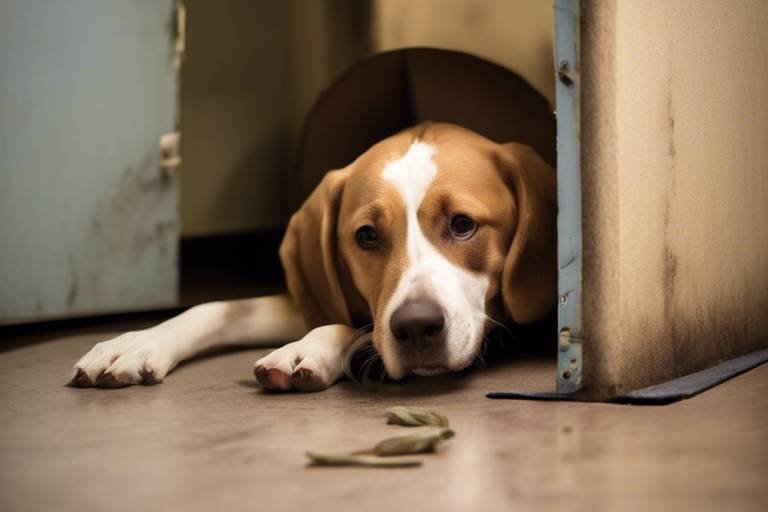How to Create a Pet First Aid Kit
This article will guide you through the essential components and steps to assemble a comprehensive first aid kit for your pets, ensuring their safety and well-being during emergencies. Just like you wouldn’t leave your home without your own essentials, your furry friends deserve the same level of preparedness. Imagine being able to swiftly respond to a scrape or a sudden illness, all because you took the time to prepare a pet first aid kit. It’s not just about having supplies; it’s about being ready to act when every second counts. So, let’s dive into how you can create a kit that’s not only effective but also tailored to your pet’s specific needs.
A pet first aid kit is crucial for every pet owner. It prepares you for emergencies, allowing you to provide immediate care before professional help arrives, potentially saving your pet's life. Think about it: just like you would have a first aid kit for humans, having one for your pets is equally important. Whether it’s a minor cut from a playful romp in the park or a more serious situation, having the right tools at your fingertips can make all the difference. Plus, being prepared helps reduce panic and ensures you can focus on your pet’s needs when they need you the most.
Knowing what to include in your pet first aid kit is vital. This section outlines must-have items that cater to various emergencies, ensuring you’re well-prepared for any situation. Remember, the goal is to cover a wide range of potential issues, from minor injuries to serious health crises. A well-stocked kit can give you peace of mind, knowing that you have the tools to handle unexpected situations.
Basic medical supplies are the foundation of any first aid kit. This includes items like gauze, bandages, and antiseptic wipes to treat minor injuries effectively. These supplies can help you manage wounds, control bleeding, and disinfect cuts. For example, if your dog gets a thorn stuck in its paw, having gauze and antiseptic wipes on hand can allow you to clean and bandage the area before heading to the vet. Here’s a quick rundown of some basic supplies you should consider:
- Gauze pads
- Adhesive bandages
- Antiseptic wipes
- Medical tape
- Scissors
Including necessary medications and treatments in your kit can be lifesaving. Learn about common medications that may be beneficial for your pet during emergencies. For instance, having a supply of antihistamines can be useful for allergic reactions, while a small bottle of hydrogen peroxide can help induce vomiting if your pet accidentally ingests something harmful. However, it’s crucial to consult your veterinarian before adding any medications to ensure they are safe and appropriate for your pet's specific needs.
Tools such as muzzles and thermometers are important for safely examining and restraining pets in distress. This ensures both your safety and your pet's during a first aid situation. A distressed pet may react unpredictably, and having a muzzle can prevent bites while you assess their condition. Additionally, knowing how to take your pet’s temperature can provide valuable information to a veterinarian, so including a digital thermometer in your kit is a smart move.
Different types of pets may require specific items in their first aid kits. For example, a first aid kit for a cat might need to include a cat-specific muzzle and a few extra calming agents, while a kit for a rabbit might require special dietary items in case of gastrointestinal issues. Understanding your pet’s unique needs is critical to ensuring their safety and well-being. Here’s a quick comparison:
| Pet Type | Essential Items |
|---|---|
| Dog | Gauze, bandages, antihistamines, muzzles |
| Cat | Calming agents, cat-specific muzzle, nail clippers |
| Rabbit | Special diet items, gentle restraint tools |
Assembling your pet first aid kit is straightforward. This section provides step-by-step instructions on gathering and organizing all essential items for easy access during emergencies. Start by selecting a sturdy container that can withstand the test of time and is easy to carry. You might want to consider a waterproof bag or box, especially if you live in an area prone to emergencies like floods or storms. Once you have your container, gather all your supplies and organize them logically. Group similar items together, perhaps using zip-lock bags to keep everything tidy.
Selecting an appropriate container for your first aid kit is essential for organization. Discover tips on choosing a durable, portable container that keeps your supplies secure. Look for a container with compartments or pockets to separate items, making it easier to find what you need in a hurry. You can even label each section for added clarity. Remember, the key is accessibility; you want to be able to grab what you need quickly without rummaging through a jumbled mess.
Maintaining and updating your pet first aid kit ensures its effectiveness. This section emphasizes the importance of checking expiration dates and replenishing supplies regularly. Just like you wouldn’t want expired medications in your own first aid kit, the same goes for your pet’s. Set a reminder every few months to review your kit, replace any used items, and check for expired medications. Keeping your kit up-to-date is a small effort that can lead to significant peace of mind.
Knowing how to use the items in your first aid kit is just as important as having them. This section highlights resources and training opportunities for pet first aid skills. Consider taking a pet first aid course, which can provide you with hands-on experience and valuable knowledge. Many organizations offer online courses that you can complete at your own pace, making it easier to fit into your busy schedule. Additionally, familiarize yourself with basic pet CPR techniques and learn how to recognize signs of distress in your pet, so you're always ready to act.
Q: How often should I check my pet first aid kit?
A: It’s a good idea to check your pet first aid kit every few months to ensure all items are in good condition and not expired.
Q: Can I use human medications for my pet?
A: Some human medications can be safe for pets, but always consult your veterinarian before administering any medication to ensure it is appropriate.
Q: What should I do if my pet has an emergency?
A: Stay calm, assess the situation, provide immediate first aid if possible, and contact your veterinarian or an emergency animal clinic as soon as you can.

Understanding the Importance of a Pet First Aid Kit
A pet first aid kit is not just a luxury; it's a necessity for every responsible pet owner. Imagine this: your furry friend is playing in the yard, and suddenly, they get a thorn stuck in their paw. What do you do? Having a well-stocked first aid kit can mean the difference between a minor inconvenience and a serious medical emergency. Just like we prepare for unexpected situations in our lives, our pets deserve the same level of care and preparedness.
In emergencies, time is of the essence. A pet first aid kit allows you to provide immediate care before you can rush your pet to the vet, potentially saving their life. Think of it as your pet's personal superhero, ready to swoop in at a moment's notice. It equips you with the tools and knowledge to handle various situations, from minor cuts and scrapes to more severe conditions like allergic reactions or choking. Being prepared can give you peace of mind, knowing that you're ready to act when it matters most.
Moreover, a well-organized pet first aid kit not only helps in emergencies but also promotes a sense of responsibility. It encourages pet owners to be proactive about their pets' health and safety. You wouldn’t drive a car without a spare tire, right? Similarly, you shouldn’t own a pet without a first aid kit. It's about being ready for those unexpected bumps in the road.
To clarify the importance further, here are some key reasons why having a pet first aid kit is essential:
- Immediate Response: Quick access to medical supplies can help stabilize your pet until professional help arrives.
- Peace of Mind: Knowing you're prepared for emergencies reduces anxiety and allows you to focus on caring for your pet.
- Cost-Effective: Treating minor injuries at home can save you money on vet visits.
- Informed Care: A first aid kit can empower you with the knowledge to handle common pet emergencies.
In conclusion, a pet first aid kit is a crucial investment in your pet's health and safety. It’s not just about having supplies; it's about being prepared, informed, and ready to act in times of need. So, take the time to assemble your kit, and remember that your furry companion's well-being is worth every effort!

Essential Items for Your Pet First Aid Kit
When it comes to your furry friends, being prepared is not just a good idea—it's essential. A well-stocked pet first aid kit can mean the difference between a minor mishap and a major crisis. So, what exactly should you include in this vital kit? Let's dive into the must-have items that will help you tackle a variety of emergencies with confidence and ease.
First and foremost, you need basic medical supplies. These are the bread and butter of your kit, providing the tools necessary to address minor injuries effectively. Essential items include:
- Gauze pads - Perfect for covering wounds and preventing further injury.
- Adhesive tape - To secure gauze and bandages in place.
- Antiseptic wipes - To clean wounds and prevent infection.
- Scissors - For cutting tape, gauze, or even fur if necessary.
- Tweezers - To remove splinters or ticks safely.
Next on the list are medications and treatments. Just like humans, pets can benefit from certain medications during emergencies. Consider including the following:
- Hydrogen peroxide - Useful for inducing vomiting in certain poisoning cases (consult your vet first).
- Antihistamines - For allergic reactions, but always check with your vet for the right dosage.
- Prescription medications - If your pet has any ongoing health issues, ensure you have their medications on hand.
To ensure the safety of both you and your pet during a first aid situation, having the right tools for restraint and examination is crucial. This includes:
- Muzzles - Even the sweetest pets can bite when they’re in pain. A muzzle can help prevent this.
- Thermometer - To check your pet's temperature, which can be a vital sign of distress.
- Pet carrier - For safely transporting your pet to the vet if needed.
It’s also important to recognize that different pets may require specific items in their first aid kits. For instance, dogs might need larger bandages due to their size, while cats may require more gentle handling tools. If you have small animals like rabbits or guinea pigs, consider including items like:
- Small animal-safe bandages - To accommodate their delicate skin.
- Specialized medications - That cater to their unique health needs.
In summary, assembling a comprehensive pet first aid kit involves gathering a variety of supplies that cater to different potential emergencies. By being proactive and equipping yourself with the right tools, you can ensure that you’re ready to provide immediate care when it’s needed the most. Remember, a little preparation goes a long way in keeping your beloved pets safe and sound!
Here are some common questions pet owners have about assembling a pet first aid kit:
- How often should I check my pet first aid kit? - It’s a good idea to check your kit every few months to ensure that all items are in good condition and that medications are not expired.
- Can I use human medications on my pets? - Not all human medications are safe for pets. Always consult your veterinarian before administering any medication.
- Where should I store my pet first aid kit? - Keep it in a cool, dry place that is easily accessible. Make sure all family members know where it is located.
Basic Medical Supplies
When it comes to assembling a first aid kit for your beloved pet, form the backbone of your emergency preparedness. Just like a toolbox for a handyman, these supplies are essential for addressing minor injuries and ensuring your furry friend receives immediate care. Imagine you’re out on a walk, and your dog steps on something sharp—having the right supplies can make all the difference!
First and foremost, you’ll want to include gauze pads and bandages. These are vital for covering wounds and preventing infection. Gauze pads come in various sizes, so it’s wise to have a selection on hand. For larger wounds, consider using a self-adhesive bandage that sticks to itself and not your pet’s fur—this can be a game changer in a stressful situation.
Next on the list are antiseptic wipes or solutions. These are crucial for cleaning wounds before applying any dressings. Think of them as the first line of defense against bacteria. Additionally, having a thermometer specifically designed for pets is essential. A fever can indicate a serious health issue, and knowing your pet’s temperature can help you make informed decisions about seeking veterinary care.
Furthermore, don’t underestimate the importance of tweezers and scissors. Tweezers are perfect for removing splinters or ticks, while scissors can help you cut gauze or bandages to the right size. Just imagine trying to remove a tick with your bare hands—yikes! You want these tools handy and ready to go.
To keep everything organized, consider using a small, waterproof container. This will protect your supplies from moisture and keep them neatly arranged. You might even want to label sections based on the type of supplies they contain, making it easier to find what you need in a hurry. Here’s a quick breakdown of the basic supplies you should include:
| Item | Purpose |
|---|---|
| Gauze Pads | For covering wounds |
| Bandages | To secure gauze and protect injuries |
| Antiseptic Wipes | To clean wounds |
| Thermometer | To check for fever |
| Tweezers | For removing splinters or ticks |
| Scissors | For cutting gauze and bandages |
In conclusion, having a well-stocked supply of basic medical items in your pet first aid kit is not just smart; it’s essential. By being prepared, you can provide immediate care that could save your pet’s life. Always remember, the goal is to stabilize your pet until you can get them to a veterinarian. So, take some time to gather these supplies and ensure your furry companion is safe and sound!
1. How often should I check my pet first aid kit?
It's a good idea to check your kit every few months, especially to ensure that medications are not expired and that all supplies are intact.
2. Can I use human medical supplies for my pet?
While some human supplies can be used, always consult with a veterinarian before using any human medications or treatments on your pet.
3. What should I do if my pet has a serious injury?
If your pet is seriously injured, apply basic first aid if possible and seek veterinary care immediately.
Medications and Treatments
When it comes to our furry friends, being prepared is half the battle, and this is especially true when it comes to medications and treatments in your pet first aid kit. Having the right medications on hand can be a game-changer during emergencies, allowing you to provide immediate care and comfort until professional help arrives. Just like we might need a headache pill or an allergy medication, pets often require similar support. So, what should you include in your kit?
First, consider the basics. It's essential to have a selection of over-the-counter medications that are safe for your pet. For instance, aspirin can be beneficial for pain relief in dogs, but it’s crucial to know the correct dosage based on their weight. Remember, never give your pet human medications without consulting your veterinarian first, as some can be toxic.
Another important item is antihistamines. These can help alleviate allergic reactions or symptoms related to insect bites. However, always verify the appropriate type and dosage for your specific pet. Additionally, having a supply of activated charcoal can be lifesaving in cases of poisoning, as it helps absorb toxins, but again, consult your vet for guidance on its use.
Let’s not forget the importance of topical treatments. If your pet gets a cut or scrape, having a pet-safe antiseptic solution is vital to prevent infection. Products like Neosporin can sometimes be used, but ensure it’s the type without pain relief ingredients, as those can be harmful to pets. Always check with your vet for the best options.
In addition to these medications, consider including a few prescription medications that your pet may need regularly. For instance, if your dog has a chronic condition like arthritis, having their prescribed pain relief medication in your first aid kit can be crucial in an emergency. It’s a good idea to keep a small supply of these medications, along with a copy of your pet’s prescription, in case you need to show it to a vet.
Lastly, don't overlook the importance of keeping a first aid manual specific to pets in your kit. This resource can provide invaluable guidance on how to administer first aid, what medications to use, and when to seek veterinary help. Just as we would consult a guide in an unfamiliar situation, having this manual can help you act quickly and effectively when your pet needs it most.
In summary, equipping your pet first aid kit with the right medications and treatments can make a world of difference in emergencies. Always remember to check with your veterinarian about the medications that are safe and effective for your pet’s specific needs. By doing so, you’ll not only ensure their safety but also give yourself peace of mind knowing you’re prepared for whatever might come your way.
Q: What medications are safe for my dog?
A: Common safe medications include aspirin and antihistamines, but always consult your veterinarian for proper dosages and specific recommendations.
Q: Can I use human medications on my pet?
A: Not all human medications are safe for pets. Always check with your vet before administering any medication.
Q: How often should I check my pet first aid kit?
A: It's a good practice to check your kit every few months to ensure that all items are up to date and that you have everything you need.
Q: Where should I store my pet first aid kit?
A: Store your kit in a cool, dry place that is easily accessible in case of emergencies.
Tools for Restraint and Examination
When it comes to providing first aid for your furry friends, having the right tools for restraint and examination is absolutely crucial. Imagine your pet is in distress; they might react unpredictably, which can put both you and your pet at risk. That's why tools like muzzles, leashes, and even thermometers are essential in your pet first aid kit. Muzzles, for instance, can prevent biting when a pet is frightened or in pain, allowing you to examine them without fear of injury. It's a bit like having a safety net; it gives you the confidence to act quickly and effectively.
In addition to muzzles, a sturdy leash can help keep your pet in a secure position while you assess their condition. Think of it as a lifeline that keeps them grounded during a chaotic moment. A leash not only helps in controlling your pet but also provides a way to transport them safely if you need to get them to a veterinarian quickly. Furthermore, incorporating a digital thermometer into your kit allows you to check your pet's temperature, which can be an important indicator of their health status. Remember, a normal temperature for a dog or cat is usually between 100.5°F and 102.5°F. If their temperature is outside this range, it could signal an underlying issue that needs immediate attention.
Here’s a quick look at some of the essential tools for restraint and examination that you should consider including in your kit:
- Muzzles: To prevent biting during distress.
- Leashes: For securing and controlling your pet.
- Digital Thermometers: For checking your pet's temperature.
- Scissors: To cut bandages or tape safely.
- Flashlights: To examine wounds in low-light conditions.
Having these tools on hand not only prepares you for emergencies but also instills a sense of confidence in your ability to handle a crisis. Just like a firefighter needs their gear, you need your pet first aid tools ready to go. So, take a moment to gather these essential items and ensure they are easily accessible. Your pet's safety may very well depend on it!
Q: What should I do if my pet is injured and I don't have a muzzle?
A: If you don't have a muzzle, you can use a soft cloth or a bandage to create a makeshift muzzle. Just be sure it’s secure enough to prevent biting but not so tight that it restricts breathing.
Q: How do I know if my pet needs to see a vet after an injury?
A: If your pet shows signs of severe pain, bleeding that doesn’t stop, difficulty breathing, or any other concerning symptoms, it’s best to consult a veterinarian immediately.
Q: Can I use human medical supplies for my pet?
A: While some human medical supplies can be used for pets, it’s important to ensure they are safe for animal use. Always check with your vet before administering any medications or treatments.
Special Considerations for Different Pets
When it comes to creating a pet first aid kit, one size definitely does not fit all. Just as each pet has its unique personality and needs, their first aid kits should reflect those differences. For instance, the requirements for dogs can vary significantly from those for cats, rabbits, or even reptiles. Understanding these nuances is essential to ensure that you are fully prepared for any emergency that may arise.
Let’s take a closer look at what you might need for different types of pets:
- Dogs: For our canine companions, consider including items such as:
- Elastic bandages for wrapping injuries on their limbs.
- Adhesive tape to secure dressings without sticking to their fur.
- Hydrogen peroxide for inducing vomiting in case of poisoning (but only under veterinary guidance).
- Cats: Cats often have different needs:
- Cat-specific nail clippers for trimming their claws if they get snagged.
- Flea and tick treatments, as cats are often exposed to outdoor pests.
- Small syringes for administering liquid medications.
- Small Animals (Rabbits, Guinea Pigs, etc.): These pets require special attention:
- Soft cloths for gentle handling, as they can be easily stressed.
- Specialized food supplies in case of digestive issues.
- Reptiles: Reptiles come with their own set of challenges:
- Thermometers to monitor their environment since they are ectothermic.
- Specific medications for common reptile ailments.
It’s also important to remember that certain conditions or emergencies may be more prevalent in specific pet types. For example, brachycephalic breeds of dogs, like Bulldogs and Pugs, may require additional items to address breathing difficulties. Similarly, older pets may need medications for arthritis or other age-related concerns.
In summary, tailoring your pet first aid kit to the specific needs of your furry, scaly, or feathery friends can make all the difference in an emergency. By understanding the unique requirements of each pet type, you’ll be better equipped to handle any situation that arises. It’s not just about having the right tools; it’s about knowing your pet and being prepared for whatever life throws your way.
1. How often should I check my pet first aid kit?
It's a good idea to check your pet first aid kit every three to six months to ensure that all items are in good condition and within their expiration dates.
2. Can I use human medications on my pets?
Some human medications can be toxic to pets. Always consult your veterinarian before administering any medications to your pet.
3. What should I do if my pet gets injured?
Remain calm and assess the situation. Use your first aid kit to provide immediate care, and then contact your veterinarian for further assistance.
4. Is it necessary to take a pet first aid course?
While it's not mandatory, taking a pet first aid course can be incredibly beneficial. It equips you with the knowledge and skills to handle emergencies effectively.

How to Assemble Your Pet First Aid Kit
Assembling your pet first aid kit is not just a task; it's an essential step in ensuring your furry friends receive the care they need in emergencies. Think of it as creating a safety net that can catch your pet when they fall. The process is straightforward, but it requires careful consideration to ensure you have everything necessary at your fingertips when panic strikes. To start, gather all the essential items we've discussed earlier, and follow these steps to organize them effectively.
First, choose the right container. The container is the backbone of your first aid kit; it should be durable and portable. Consider a sturdy plastic box with a secure lid or a soft-sided bag with compartments. This way, you can easily transport it during trips or keep it handy at home. Look for containers that are waterproof to protect your supplies from moisture, especially if you're storing them in a garage or shed. A well-organized kit makes it easy to find what you need quickly, which is crucial in emergency situations.
Next, organize your supplies based on their use. Group similar items together to avoid rummaging through the entire kit when time is of the essence. For example, keep all your medical supplies, like gauze and bandages, in one section, while medications should have their own designated area. You can use small zippered bags or dividers to keep everything neat and tidy. Labeling sections can also save you precious seconds in a crisis. Imagine needing a bandage and wasting time searching through clutter; that’s the last thing you want!
Additionally, it’s essential to regularly maintain and update your pet first aid kit. Just like you wouldn’t want to use expired medicine on yourself, the same goes for your pet. Set a reminder every few months to check the expiration dates of medications and the condition of your supplies. Replace any items that are used or expired. This routine checkup ensures that your kit is always ready to go when you need it the most. You wouldn’t drive a car without checking the oil, so why would you leave your pet’s safety to chance?
Finally, consider including a pet first aid manual in your kit. This guide can be invaluable in emergencies, providing step-by-step instructions on how to handle various situations. You can find many resources online or purchase a comprehensive manual that covers everything from CPR to treating common injuries. Having this reference at hand can give you the confidence to act quickly and effectively when every second counts.
In summary, assembling a pet first aid kit is all about preparation and organization. By selecting the right container, organizing supplies efficiently, maintaining your kit, and including a manual, you create a resource that can make a significant difference in your pet's health and safety. Remember, when it comes to emergencies, being prepared is the best way to ensure your pet's well-being.
1. How often should I check my pet first aid kit?
It's advisable to check your kit every 3-6 months to ensure all items are in good condition and not expired.
2. Can I use human medications for my pets?
Some human medications can be safe for pets, but always consult your veterinarian before administering anything to ensure it’s appropriate and safe for your specific animal.
3. Where should I store my pet first aid kit?
Store your kit in a cool, dry place that is easily accessible. Consider keeping it in a location that you can reach quickly, such as your home or car, especially during travel.
4. Should I have separate kits for different pets?
While a single kit can serve multiple pets, it’s beneficial to tailor kits for each type of pet, especially if they have different needs or sizes.
Choosing the Right Container
When it comes to assembling your pet first aid kit, one of the most crucial decisions you'll make is selecting the right container. Think of this container as the fortress that will protect your supplies. You want something that is not only durable but also portable, ensuring that you can grab it and go in a moment's notice. After all, emergencies don’t wait for you to be prepared!
First, consider the size of your container. It should be spacious enough to hold all the essential items without feeling cramped. However, it shouldn't be so large that it becomes cumbersome to carry. A soft-sided bag or a sturdy plastic box can work wonders. Look for containers that have multiple compartments, allowing you to organize your supplies efficiently. This way, when you need a specific item, you won’t have to dig through a chaotic jumble of supplies.
Next, think about the material of the container. You want something that can withstand the rigors of travel and the unpredictability of emergencies. Waterproof materials are ideal, as they will protect your supplies from moisture and spills. Additionally, consider containers that have secure closures. Zippers, buckles, or clips can prevent accidental openings during transport, ensuring that everything stays in place.
Another important factor is visibility. When you’re in a stressful situation, the last thing you want is to fumble around looking for a bandage. Clear containers or bags with transparent pockets can help you quickly identify what you need at a glance. It’s like having a map in a foreign land; it saves you time and reduces anxiety.
Lastly, don’t forget about accessibility. If you have multiple pets, consider a container that is easy to open with one hand, allowing you to keep the other hand free to hold your pet securely. You might even want to label the outside of your kit with a simple sticker indicating that it’s a first aid kit, so anyone can quickly identify it in an emergency.
In summary, choosing the right container for your pet first aid kit is about balancing size, material, visibility, and accessibility. Take your time to find the perfect match, and remember, this small investment can make a world of difference when it comes to your pet's safety and well-being.
- What items should be included in a pet first aid kit? A comprehensive kit should include basic medical supplies, medications, and tools for restraint and examination.
- How often should I check my pet first aid kit? It's recommended to check your kit at least every six months to ensure all items are up-to-date and in good condition.
- Can I use human first aid supplies for my pet? Some human supplies can be used, but always consult your veterinarian for specific recommendations.
- Where should I store my pet first aid kit? Store it in a cool, dry place that is easily accessible, but out of reach of pets.
Regular Maintenance and Updates
Just like your pet needs regular check-ups at the vet, your pet first aid kit also requires periodic attention to ensure it remains effective and ready for any emergency. Think of it as a living entity that needs care and nourishment to function properly. Regular maintenance involves a few simple yet crucial steps that can make a world of difference when the unexpected occurs.
First and foremost, it's essential to check expiration dates on medications and supplies. Many items in your kit, such as antiseptics, ointments, and even some bandages, can lose their effectiveness over time. Imagine reaching for a crucial item only to find it's expired—this could be a nightmare in an emergency! Set a reminder on your calendar to review your kit every six months. This way, you can ensure that everything is up to date and ready to go.
Another vital aspect of maintenance is replenishing supplies after use. If you’ve had to use a bandage or some antiseptic, replace those items right away. It’s easy to forget about these small details, but being proactive can save you a lot of stress later. Consider creating a checklist of items to monitor, which can help streamline the process. Here’s an example of what that checklist might include:
| Item | Expiration Date | Status |
|---|---|---|
| Antiseptic Wipes | MM/YYYY | Check |
| Gauze Pads | MM/YYYY | Check |
| Adhesive Bandages | MM/YYYY | Check |
Lastly, don’t forget to review your pet's specific needs regularly. As pets age, their health and requirements may change, meaning you might need to adjust what’s in your kit. For instance, if your dog develops a chronic condition, you may need to add specific medications or treatments tailored for that. It’s all about being prepared for your furry friend’s unique situation.
By taking the time to maintain and update your pet first aid kit, you’re not just ensuring that you have the right tools at your disposal; you’re also showing your love and commitment to your pet’s health and well-being. After all, in the face of an emergency, having a well-stocked and current first aid kit can be the difference between a small scare and a significant crisis.
- How often should I check my pet's first aid kit? It's recommended to check it every six months to ensure all items are up to date and in good condition.
- What should I do if I find expired items? Discard any expired items and replace them immediately to ensure your kit is always ready for emergencies.
- Can I use human medications on my pets? Some human medications can be harmful to pets. Always consult your veterinarian before using any medication.
- Where should I store my pet first aid kit? Keep it in a cool, dry place that is easily accessible in case of an emergency.

Training Yourself in Pet First Aid
When it comes to our furry friends, being prepared is half the battle. Just like you wouldn’t head into the wilderness without a map, you shouldn’t venture into pet ownership without knowing how to handle emergencies. is not just a good idea; it's an essential part of responsible pet ownership. Imagine the peace of mind you’ll have knowing that you can act swiftly and effectively in a crisis. So, how do you get started?
First off, consider enrolling in a pet first aid course. Many organizations, like the American Red Cross or local animal shelters, offer workshops that cover everything from basic first aid techniques to CPR for pets. These courses often include hands-on practice, which is invaluable. Just think of it as a workshop where you learn to be your pet's superhero—ready to swoop in and save the day!
In addition to formal training, you can also find a wealth of resources online. Websites dedicated to pet care often have instructional videos and articles that can enhance your knowledge. However, always ensure that the information comes from a reputable source. After all, you wouldn’t trust just anyone with your pet’s health, right?
Another great way to reinforce your learning is through practice. You can gather your family and friends and conduct mock scenarios where you practice applying bandages or performing CPR on a stuffed animal. This not only helps you remember the techniques but also makes it a fun and engaging experience. Plus, who wouldn’t want to show off their newfound skills?
Lastly, keep your first aid knowledge fresh by regularly reviewing the materials and techniques you’ve learned. Just like any skill, if you don’t use it, you might lose it. Set reminders to revisit your training every few months. You could even create a little “Pet First Aid Manual” for yourself, filled with tips, diagrams, and emergency contacts. This way, you’ll have a handy reference guide when you need it the most.
In summary, training yourself in pet first aid is an investment in your pet's safety. With the right knowledge and skills, you can confidently navigate emergencies and ensure your furry companion receives the care they need. Remember, it’s not just about having a first aid kit; it’s about knowing how to use it effectively. So, roll up your sleeves, dive into some training, and become the hero your pet deserves!
- What should I do if my pet gets injured?
Stay calm and assess the situation. If it's a minor injury, you can treat it at home with your first aid kit. For severe injuries, contact your veterinarian immediately.
- How often should I update my pet first aid kit?
It's recommended to check your kit every six months to ensure that all supplies are in good condition and that medications have not expired.
- Can I take a pet first aid course online?
Yes! Many organizations offer online courses that cover essential first aid techniques for pets.
- What is the most important item in a pet first aid kit?
While all items are important, having a good supply of gauze and bandages is crucial for treating wounds.
Frequently Asked Questions
- What items should I include in my pet first aid kit?
Your pet first aid kit should include essential items such as gauze, adhesive bandages, antiseptic wipes, scissors, tweezers, and a digital thermometer. Don't forget to add any specific medications your pet may need, as well as a muzzle for safety during emergencies.
- How do I choose the right container for my pet first aid kit?
When selecting a container, look for something durable, portable, and waterproof. A hard-sided case is often best, as it protects the contents from damage. Ensure that it has compartments or dividers to keep your supplies organized and easily accessible during an emergency.
- How often should I check and update my pet first aid kit?
It's crucial to check your pet first aid kit at least every six months. Look for expired medications, used supplies, or anything that needs replenishing. Regular maintenance ensures that you are fully prepared when emergencies arise.
- Can I use human medications on my pets?
Some human medications can be used for pets, but it's essential to consult your veterinarian first. Dosages and medications that are safe for humans may not be safe for pets, so always seek professional advice before administering any medication.
- What should I do if my pet has a medical emergency?
In case of a medical emergency, stay calm and assess the situation. Use your first aid kit to provide immediate care if necessary, and contact your veterinarian or an emergency animal clinic as soon as possible. Remember, your quick response could make a significant difference.
- Is there any training available for pet first aid?
Yes! Many organizations offer pet first aid courses. These courses teach you how to handle various emergencies, use your first aid kit effectively, and provide the best care for your furry friends. It's a worthwhile investment in your pet's health and safety.



















